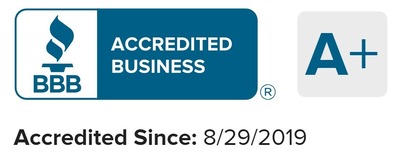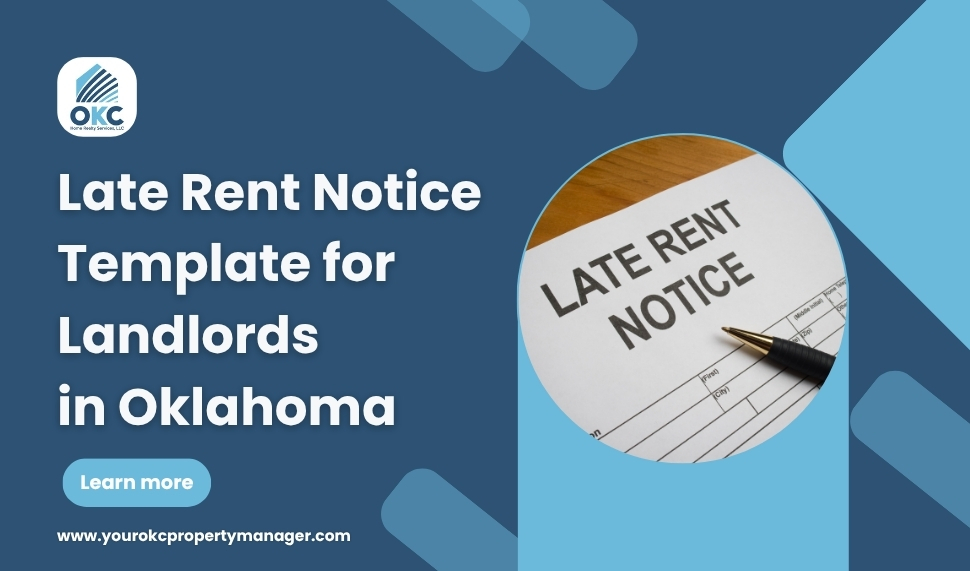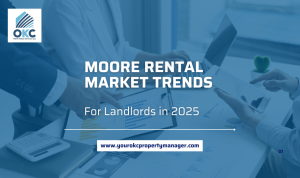Managing rental properties comes with its fair share of challenges, and one of the most common issues landlords face is late rent payments. According to the most recent data available as of November 2024, 14% of renters in the United States reported paying their rent late at least once in the past year. As a landlord or property manager, having a clear, professional, and legally compliant process for addressing late rent is crucial, not just for your peace of mind but for maintaining positive tenant relationships and protecting your investment.
At OKC Property Manager, we understand the delicate balance between enforcing lease terms and fostering goodwill with tenants. A well-crafted late rent notice is more than just a reminder; a formal document that helps you document communication, set expectations, and comply with local laws. When handled correctly, it can resolve payment issues quickly and amicably, minimizing disruption to your cash flow and avoiding unnecessary escalation.
In this article, with my over 15 years of experience, I’ll provide you with everything you need to know about late rent notices, from what they are and when to send them, to providing a downloadable template and tips for automating reminders. Here, you’ll find actionable advice and expert insights to help you handle late rent situations with confidence and professionalism.
What is a late rent notice?
A late rent notice, also known as a past-due rent notice, is a formal, written document sent by a landlord or property manager to a tenant, notifying them that their rent payment is overdue.
This notice serves several important purposes:
- Formal Notification: It officially informs the tenant that they have violated the lease agreement by not paying rent on time.
- Opportunity to Remedy: It gives the tenant a chance to pay the overdue amount before any further action is taken.
- Documentation: It creates a paper trail in case the issue escalates, which can be crucial if legal proceedings become necessary.
- Clarification of Consequences: It outlines any late fees, deadlines, and potential next steps, ensuring both parties are on the same page.
What is included in a late rent notice?
A past-due rent notice includes the following details:
- Rental Property Address: Specify the exact location of the rental unit to avoid any confusion.
- Tenant’s Full Name: Address the notice directly to the tenant responsible for the payment.
- Date of the Notice: Include the date you are issuing the notice to keep a clear record.
- Original Rent Due Date: Remind the tenant of the rent’s original rent due date to highlight the delay.
- Outstanding Balance: Clearly state the amount of rent that is past due.
- Late Fees or Penalties: Mention any additional charges applied because of the late payment.
- Instructions for Payment: Provide straightforward steps on how and where the tenant can make the payment.
When should you send a late rent notice?
Timing is everything when it comes to sending a late rent notice. The right time to send one depends on your lease agreement and local laws, but here are some general guidelines:
- After the Due Date: If rent isn’t received by the due date specified in the lease, you can prepare to send a late rent notice.
- After the Grace Period: Many leases include a grace period (usually 3-5 days) during which tenants can pay late without penalty. Only send the notice after this period has ended.
- Partial Payments: If a tenant pays only part of the rent, you should send a notice for the remaining balance.
For example, if rent is due on the 1st and your lease allows a 3-day grace period, you would send the late rent notice on the 4th if payment hasn’t been received. Always check your state and local regulations, as some areas have specific requirements about when and how notices must be delivered.
Here’s a sample template of a late rent notice to download, use and customize for your rental property. So, having a template on hand streamlines the process and ensures you include all necessary information.
Providing a late rent notice
Delivering the late rent notice correctly is just as important as the content itself. Here are the most common and legally recognized delivery methods:
- Certified Mail: This method offers a paper trail. It not only ensures the tenant receives the notice, but it also gives you a receipt as proof of delivery, which is legally required in many jurisdictions.
- Email: You can email the notice as a PDF attachment, but be sure to request a read receipt or written confirmation from the tenant. Keep in mind that not all states consider email a valid legal delivery method, so double-check local laws before relying solely on this approach. You can go through the article: Is an email considered a written notice?
- In-Person Delivery: Handing the notice directly to your tenant can be effective and immediate. Just make sure to have them sign a copy or an acknowledgement form whose signature acts as your proof.
- Posting at the Property: In some areas of the states, especially when other methods fail, it’s legal to post the notice on the tenant’s door. Be sure to place it in a visible, weather-protected, and secure spot to avoid claims that the tenant never saw it.
So, always keep copies of the notice and proof of delivery for your records. This documentation is essential if you need to escalate the matter or initiate legal proceedings.
How to Automate Rent Reminder Emails
Automating rent reminders can significantly reduce the chances of late payments and save you time. Modern property management platforms, such as TurboTenant, Buildium, and others, offer features like:
- Automated Payment Reminders: With this feature, your tenants receive timely reminders through email or SMS in the days leading up to the rent due date. These gentle nudges help them stay aware of upcoming payments, reducing the chances of forgetfulness. You can customize how often and when these reminders go out, whether it’s a week before, a day before, or even on the due date itself.
- Recurring Payment Options: Many platforms allow tenants to set up recurring monthly payments, which eliminates the need for them to manually send rent each time. This not only ensures on-time payments but also makes the process smoother and stress-free for both the tenant and the landlord. Think of it as “set it and forget it” for rent.
- Online Rent Collection: Instead of waiting for checks or dealing with cash, tenants can pay their rent online using a secure portal. You get instant confirmation when the payment is made, and tenants get a digital receipt, so there’s a clear, trackable record for everyone involved. This is especially helpful for reducing disputes or confusion.
- Late Fee Automation: If the rent isn’t paid by the due date, the system can automatically apply a late fee based on your lease terms. There’s no need for awkward conversations or manual tracking’s all done for you. This encourages tenants to pay on time and ensures your policies are consistently enforced.
Using these tools not only improves your rent collection process but also enhances the tenant experience by providing convenience and transparency.
What if a tenant continues to be late on rent?
Sometimes, a late rent notice isn’t enough to resolve the issue. If a tenant repeatedly pays late or ignores notices, you may need to escalate your response.
What is a pay or quit notice?
A pay or quit notice is a formal legal document that gives the tenant a final opportunity to pay the overdue rent or vacate the property. This notice is typically the first step in the eviction process and must comply with state and local laws regarding content, delivery, and timelines.
A pay or quit notice usually includes:
- The total amount due (including late fees)
- A clear deadline for payment or vacating (often 3-5 days)
- Consequences of failing to comply (such as eviction proceedings)
If you’re in Oklahoma, here’s what you need to know about the 5-day notice to quit and how to issue it properly. For these, consult with a local attorney to ensure your notice meets all legal requirements before sending it.
Should you accept partial rent payments?
Accepting partial rent payments can be risky. In some jurisdictions, taking a partial payment may waive your right to proceed with eviction or enforce certain lease terms. It can also create confusion about the remaining balance and payment expectations. Before making a decision, make sure you understand what happens if a landlord accepts a partial rent payment, especially in your local jurisdiction. Always check your local laws and consult with an attorney before accepting partial payments from tenants who are behind on rent.
How to prevent late rent payments?
Prevention is always better than a cure. Here are some proactive steps you can take to minimize late rent payments:
- Clear Lease Terms: Make sure your lease agreement leaves no room for confusion. Clearly outline all the important details, such as when rent is due, what the grace period is (if any), how much the late fee is, and the consequences of not paying on time. Also, include acceptable payment methods and how payments should be made. The clearer your lease, the easier it is to enforce it later.
- Tenant Screening: Never underestimate the power of proper screening. Go beyond just checking credit scores—look for a consistent rental history, verify employment, and ask for landlord references. A tenant with a track record of paying on time is far less likely to become a problem down the road. You May Also Read: How to screen tenants effectively
- Automated Reminders: Technology can be your best friend here. Property management tools like TurboTenant, AppFolio, or Buildium can automatically remind tenants of upcoming rent due dates via email or text. You can also enable recurring notifications and receipts, so tenants always know where they stand and when to pay.
- Flexible Payment Options: Today’s tenants expect convenience. Offering multiple rent payment methods—such as ACH transfers, credit or debit cards, mobile payment apps, and online portals—can remove common barriers to timely payments. The more flexible and accessible the process, the less likely tenants are to miss deadlines.
- Open Communication: Make sure your tenants know they can talk to you if they’re facing financial trouble. Create an open-door policy where they feel comfortable notifying you before rent is late. This allows you to discuss temporary solutions, such as payment plans or short extensions, before the situation worsens.
Useful Tools & Forms
Being a proactive landlord doesn’t mean doing everything manually. Using the right tools can save you time and make your operations more efficient.
- Online Rent Collection Platforms: Modern platforms like TurboTenant, Buildium, and RentRedi can streamline rent collection, automate late notices, and maintain digital records of all transactions. Some even allow tenants to set up auto-pay so rent is never late again.
- Customizable document Templates: Keep a library of essential documents like late rent notices, payment plan agreements, lease templates, and renewal forms. Having ready-to-use templates can make your responses quick and professional when issues arise.
- Comprehensive accounting Dashboards: These tools offer more than just rent tracking, they provide detailed insights into your rental income, payment histories, outstanding balances, and communication logs. Everything is organized in one place, making end-of-year tax prep or legal documentation much simpler.
Create or Manage Your Listings
Believe it or not, late rent issues can often be avoided right from the listing stage. Attracting the right tenants and managing them effectively from the first click makes a big difference:
- Update and Optimize Your Online Listings: Make sure your listings are up-to-date, well-written, and listed across all major rental platforms. The better your property appears online, the more interest you’ll generate from qualified applicants who are ready and able to pay on time.
- Use Reliable Screening Tools: Use online tenant screening tools that integrate with your listing platforms. Look for services that provide credit, criminal, and eviction reports, along with income verification. This gives you a full picture of who you’re renting to.
- Digital Lease Management: Simplify the lease signing process with electronic lease agreements. Not only is it faster and more convenient, but it also helps ensure that terms like rent due dates and payment methods are clearly presented and digitally acknowledged by both parties.
- Application Management Systems: With so many applicants, you need a way to stay organized. Use systems that track applications, schedule showings, and allow you to message prospects directly. The smoother your application process, the sooner you’ll find the right tenants.
Conclusion: Late Rent Notice
Dealing with late rent is an inevitable part of being a landlord, but it doesn’t have to be stressful or adversarial. By using a clear, professional late rent notice template and following best practices for communication and documentation, you can resolve most issues quickly and maintain positive relationships with your tenants.
At OKC Property Manager, we’re dedicated to helping landlords navigate every aspect of property management, from rent collection to tenant screening and beyond. With the right tools, templates, and strategies, you can protect your investment and ensure a smooth rental experience for everyone involved.
FAQs on Past Due Rent Notice
Late rent notice vs 3-day pay or quit notice: What's the difference?
A late rent notice is an initial reminder to the tenant that their rent is overdue, giving them a chance to pay before any further action is taken. A 3-day pay or quit notice is a formal legal document that demands payment within a specific timeframe (usually three days) or requires the tenant to vacate the property. The pay or quit notice is often the first step in the eviction process if the late rent notice does not resolve the issue.
What is a letter for overdue rent?
A letter for overdue rent, also known as a late rent notice, is a written communication from the landlord to the tenant informing them that their rent payment is past due. It includes details such as the amount owed, any late fees, the payment deadline, and the consequences of non-payment. This letter serves as both a reminder and a formal record of the late payment.
What's the best way to collect rent and avoid late rent?
The best way to collect rent and avoid late payments is to use an online rent collection platform that offers automated reminders, recurring payment options, and multiple payment methods. Thorough tenant screening, clear lease terms, and regular communication also play a vital role in ensuring timely rent payments. Leveraging technology and maintaining professionalism can significantly reduce the incidence of late rent and streamline your property management process. For more information, you can go through the article: Best ways to collect rent

Author
Scott Nachatilo is an investor, property manager and owner of OKC Home Realty Services – one of the best property management companies in Oklahoma City. His mission is to help landlords and real estate investors to manage their property in Oklahoma.
 (
(









